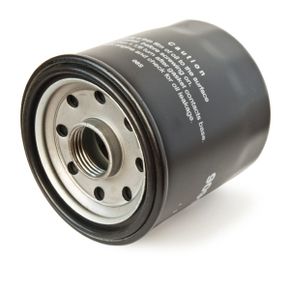Change Oil Filter
The next important step in changing your oil is replacing the oil filter. Remember, the oil filter holds all the excess sludge and grime that the oil catches while lubricating the engine. Changing the filter is vital to car maintenance because without a new oil filter in place, new engine oil will be passing through the old filter, making it dirty and less effective. You can check your car's manual to find out which size filter you'll need. They can be purchased at any auto maintenance shop for around $5, or up to about $20 for performance filters.
When you're under the vehicle draining the oil, locate the oil filter. It will be cylindrical and may be blue, white, black or orange depending on the brand. Use the oil filter wrench, available at any automotive maintenance shop, and turn it counterclockwise to loosen the filter. The old filter will have hot oil inside it so be careful when taking it off. One turn with the wrench should loosen it up enough to twist it off the rest of the way by hand.
Advertisement
Before installing the new oil filter, first take a little bit of clean oil and rub it around the rubber gasket of the new filter. This will help the new filter fit snugly onto the engine block. For good vehicle maintenance, it's also a good idea to use a rag to clean off any excess oil around the area where the filter screws onto the engine. Take the new filter and screw it on the engine block by hand. Once it's snug, tighten it with the oil filter wrench. It should take about a half to three-quarters of a turn to get it firmly in place. Remember, you want the filter on tight, but don't over-tighten it either; you could damage the filter and cause it to leak.
On the next page, you'll learn how to fill your car's engine with the proper amount of oil.
